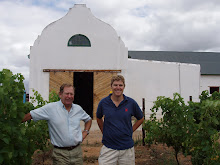We are half way through spring in the Robertson Valley. This is actually the busiest time of the year in the vine’s cycle. Many people believe that harvest is busier, but I find that harvest is fairly routine. During springtime you have to do the following:
· Suckering – this is the removal of excess shoots (very time consuming)
· Lifting trellis wires – to stop shoots being blown off during strong spring winds, which we experienced last night.
· Trim the shoots when they reach a certain height, otherwise they will topple over and become unruly.
· Monitor for disease – Powdery mildew is the most common disease followed by Downy mildew.
· Spray if disease is identified.
So far the jobs have gone well, but we do have a small outbreak of downy mildew. This is fungal disease, which you first identify on the leaf as an “oil spot”. The disease can attack the bunch as well, especially during flowering. It causes the young bunch to wither away and die, which is obviously a financial problem. Ideal conditions for the development of the disease is known as the 10, 10, 24 combination. This stands for:
· 10 millimeters of rain
· A temperature of greater that 10 degrees Celsius
· The leaf must be wet for 24 hours or longer.
We have had two such events in the last two weeks. We have already seen the first “oil spots” on the leaves, so we have to dust-off the spray carts and get to work. We do not like spraying, and in a normal year we do not spray at all (thanks to Robertson’s healthy climate), but in this situation it is not worth the risk.
We generally use contact sprays, as the plant does not take them up. We are using copper, as this kills the mildew, and as been used for centuries on vines. Organic growers tend to use copper for downy mildew, but in different formats to us.
This is one of the aspects of grape growing where you have to weigh up the advantages and disadvantages of certain actions. In this case we believe that the advantages outweigh the disadvantages.
Monday, October 26, 2009
Saturday, October 10, 2009
US and Chardonnay
I have just spend close to 3 weeks traveling around North America – more specifically LA, Vancouver, NY, New Jersey and Memphis. Yes I did go to Graceland, and Beale street, and ate great BBQ!
Selling wine in the US is great becomes you get direct honest feedback. If people feel that they can sell your wine and make a couple of bucks, they will buy. One thing that struck me on this trip was how amazed people were with our Chardonnay.
I was often told – I don’t drink Chard, its too oaky, or I have too many Chards on my shelf, so why would I carry a South African one. Once they tried the Excelsior, they were invariably impressed and bought the wine.
We produce a very lightly oaked style (many asked if there is any oak in the wine) that has good acidity. More importantly, there is no malo-lactic fermentation done on the wine, which gives chardonnay those typically buttery flavours. Our flavour profile is lemony, and fresh. The wine definitely tastes like Chard, but we want the consumer to reach for a second (and even third) glass.
I believe the wine industry missed a trick by producing oceans full of those oaky, oily chardonnays, as the consumers have been totally turned off by them.
Selling wine in the US is great becomes you get direct honest feedback. If people feel that they can sell your wine and make a couple of bucks, they will buy. One thing that struck me on this trip was how amazed people were with our Chardonnay.
I was often told – I don’t drink Chard, its too oaky, or I have too many Chards on my shelf, so why would I carry a South African one. Once they tried the Excelsior, they were invariably impressed and bought the wine.
We produce a very lightly oaked style (many asked if there is any oak in the wine) that has good acidity. More importantly, there is no malo-lactic fermentation done on the wine, which gives chardonnay those typically buttery flavours. Our flavour profile is lemony, and fresh. The wine definitely tastes like Chard, but we want the consumer to reach for a second (and even third) glass.
I believe the wine industry missed a trick by producing oceans full of those oaky, oily chardonnays, as the consumers have been totally turned off by them.
Subscribe to:
Posts (Atom)
